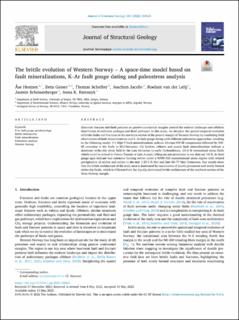The brittle evolution of Western Norway – A space-time model based on fault mineralizations, K–Ar fault gouge dating and paleostress analysis
Hestnes, Åse; Gasser, Deta; Scheiber, Thomas; Jacobs, Joachim; van der Lelij, Roelant; Schönenberger, Jasmin; Ksienzyk, Anna Katharina
Peer reviewed, Journal article
Published version
Permanent lenke
https://hdl.handle.net/11250/3059644Utgivelsesdato
2022Metadata
Vis full innførselSamlinger
- Import fra CRIStin [3580]
- Institutt for miljø- og naturvitskap [528]
Originalversjon
10.1016/j.jsg.2022.104621Sammendrag
Basement fracture and fault patterns on passive continental margins control the onshore landscape and offshore distribution of sediment packages and fluid pathways. In this study, we decipher the spatial-temporal evolution of brittle faults and fractures in the northern section of the passive margin of Western Norway by combining field observations of fault mineralizations and K–Ar fault gouge dating with different paleostress approaches, resulting in the following model: (1) High-T fault mineralizations indicate Silurian NW-SE compression followed by NW-SE extension in the Early to Mid-Devonian. (2) Epidote, chlorite and quartz fault mineralizations indicate a dominant strike-slip stress field in the Late Devonian to early Carboniferous. (3) E-W extensional stress fields which could be related to Permo-Triassic or Late Jurassic rifting are not prominent in our data set. (4) K–Ar fault gouge ages indicate two extensive faulting events under a WNW-ESE transtensional stress regime with related precipitation of zeolite and calcite in the mid (123-115 Ma) and late (86-77 Ma) Cretaceous. Our results show that the brittle architecture of the study area is dominated by reactivation of ductile precursors and newly formed strike-slip faults, which is different from the dip-slip dominated brittle architecture of the southern section of the West Norway margin.

